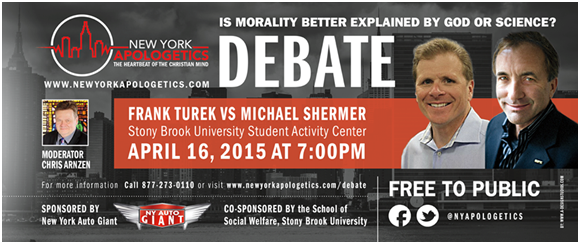On April 16, I, Frank Turek, debated atheist Michael Shermer at Stony Brook University on the question: “What Better Explains Morality: God or Science?” Following the debate, the Graduate Queer Alliance at Stony Brook wrote a letter to the editor of the school newspaper wanting an apology from the university for allowing me to speak because I expressed my opposition to homosexual behavior and same sex marriage. They also want shut down all future debate on such topics claiming that opposition is “hate speech.” Dr. Shermer and I decided to issue a joint response to their false assertions and totalitarian demands. Here it is.
By Dr. Michael Shermer & Dr. Frank Turek
It’s not often that an atheist and a Christian, who have just had a debate on campus, can be brought into agreement by a group in the audience. But the Graduate Queer Alliance (GQA) at Stony Brook University has managed to do that. Their letter to the editor on April 30 was so full of false assertions and totalitarian demands that we, Dr. Michael Shermer (an atheist) and Dr. Frank Turek (a Christian), felt compelled to write this letter together in response.
The central assertion of the GQA is that anyone who expresses a negative opinion of same sex marriage or homosexual behavior is guilty of “hate speech” and should be barred from speaking at Stony Brook University. The GQA says this while also claiming to believe “that a university should provide an open forum for controversial ideas to be discussed and debated.” We both wonder how the GQA can hold these two contradictory opinions at the same time. After all, they say they are for the debate of controversial issues, but apparently only if both debaters hold the same position and that position agrees with the GQA. Some debate!
How is disagreement over controversial moral and political issues “hate speech?” If it is then GQA’s position is “hate speech” because it disagrees with people who believe marriage should be defined in other ways. Calling people names or characterizing their arguments as “hate speech” is not good public discourse designed to discover the truth; it is bullying—the very thing GQA should be against.
To demonstrate the oversensitivity of the GQA, you should know that our debate was not even about same sex marriage or homosexuality. Our debate was about whether God or Science better explains morality. As you can see for yourself in the debate here, Dr. Turek never mentioned homosexuality or same sex marriage in his prepared opening statement. Dr. Shermer brought up those issues in his opening statement as examples of what he believes to be moral progress (hence the title of this book, The Moral Arc). Dr. Turek expressed disagreement with Dr. Shermer’s point only when Dr. Shermer pressed him to comment during the cross-examination period. (Imagine, a debate where the debaters disagree!)
The true motives of the GQA are revealed by what is not in the letter: the arguments made by Dr. Shermer in support of same sex marriage, arguments he made with great passion that elicited equal passion—on both sides of the issue—from the audience. If those in the GQA are so interested in advancing their position through sound reason and science—which was Dr. Shermer’s point—why would they not highlight the arguments offered in support of it? Instead, the GQA seems to think they have a right not to hear an opposing opinion lest they be challenged!
It’s a shame that those in GQA appear so uninterested in evidence. Unfortunately for them, as the late Christopher Hitchens put it (and Dr. Shermer elevated to a principle, “Hitchens’ Dictum”, in one of his Scientific American columns ), “What can be asserted without evidence, can also be dismissed without evidence.” Instead of citing evidence, GQA attempted to smear the character of one of the debaters and now tries to silence all future debate by simply declaring that the major issues of our day have all been decided in their favor. Don’t bother debating anything. We know what’s right and you have no right to express your wrong opinion!
What’s also problematic is that none of the derogatory assertions about Dr. Turek made by the GQA are true. For example, contrary to the GQA:
- Turek has not written a book that “derides gays.” His book on same sex marriage (which they obviously haven’t read) does nothing of the sort as numerous reviewers have observed. By making a derogatory judgment without knowing the facts, those in GQA are guilty of the very bigotry with which they falsely charge Dr. Turek.
- Turek never said that gays have a choice in their sexual orientation. He believes the consensus view that the causes of sexual orientation are not entirely understood. But for him, the issue isn’t attractions—it’s actions. And we all are responsible for the actions we choose.
- Turek made no parallel between homosexuality and a Nazi propaganda video. The video was shown in Dr. Turek’s opening statement, long before Dr. Shermer brought up the issue of homosexuality. The only purpose of the video was to demonstrate that Hitler thought natural selection gave him justification to kill the weak.
Finally, on the issue of tolerance, it appears that GQA only wants to tolerate ideas they agree with. That’s not tolerance. That’s totalitarianism. You can only tolerate ideas you disagree with. Moreover, you will never learn and grow (the essence of a university) if you hear only one side of any issue. As Dr. Shermer points out in The Moral Arc by quoting same sex marriage advocate Jonathan Rauch: “Good ideas outcompete bad ideas in the marketplace of free exchange.” Now that’s a good idea rooted in the very foundation of a free society.
Unfortunately, GQA is expressing a totalitarian impulse to silence all opinions that dissent from their own. As a free people, we must not adopt such an unlearned, intolerant and unconstitutional position. This atheist and Christian agree with same sex marriage advocate Andrew Sullivan who wrote against this totalitarian impulse this way: “If this is the gay rights movement today—hounding our opponents with a fanaticism more like the religious right than anyone else—then count me out. If we are about intimidating the free speech of others, we are no better than the anti-gay bullies who came before us.”













